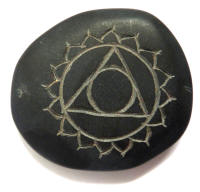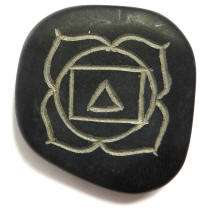

Set of Hot Massage Stones with Chakra Symbol Engravings
- $19.95 USD
$24.95 USD- $19.95 USD
- Unit price
- per
 This set of hot massage stones includes 7 polished basalt stones, each engraved with a symbol representing one of the 7 major chakras in the human body.
This set of hot massage stones includes 7 polished basalt stones, each engraved with a symbol representing one of the 7 major chakras in the human body.
The stones can be used for;
- normal hot stone massage therapy
- opening and balancing the chakras
Hot Massage Stone Therapy
The top 10 benefits of hot stone massage
- A good way to manage stress. Studies show that stress is the number one root of a lot of diseases and disorders. Whether it's stress from work, home or daily activities, the result is the same: too much stress can lead to health problems. And because we can never run away from it, the only way to deal with it is to manage stress efficiently. A hot stone massage offers some relaxing time for your mind and does wonders in releasing muscular tension. Thus this is one of the best ways to relieve you of stress.
- Effective in muscle relaxation. The heat in the stones is effective in enabling the muscles to loosen up and relax. This makes it easier for deep tissue manipulation.
- Improves health conditions. More and more doctors are beginning to recommend this therapy as part of medical treatment of a lot of health problems such as Arthritis, Fibromyalgia, Hypertension and musculoskeletal problems.
- Allows better sleep. It's really hard to get a good quality sleep when you're over fatigued. With the relaxation you get from this therapy, it makes it easier for you to doze off into a deep sleep which your body needs to recuperate from daily fatigue. This is why people who have Insomnia are often advised to get this therapy.
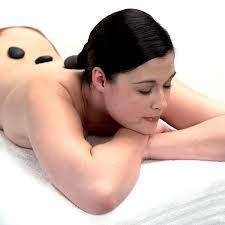
- Relieves pain. Manipulation of muscles can significantly reduce muscle spasm and give comfort to painful muscles so those who suffer from back pains or muscle aches often go for this therapy.
- Improves blood circulation and flow of energy. The stones are placed on key points of your body known as energy centres which are sometimes clogged or blocked.
- Allows for easy rehabilitation. Massage can facilitate easy recovery from injuries such as sprains.
- Releases toxins from your body. When muscles are massaged, toxins that are clogged within are released. This is why, it's advised that clients drink plenty of water after a session to help flush out those unhealthy and unwanted toxins.
- Satisfies human longing for touch. It's only human to crave for hugs and affection. But since our loved ones are not always within a hug's reach, having a hot stone massage is a good alternative to suffice this need.
- Gives you a happy feeling. A calming and soothing massage can do wonders in giving you an emotional boost, leaving you with a happier and more positive outlook in life.
- Prepare the massage stones as follows ready for your hot stone massage therapy session;
- Prepare your massage room with some aromatherapy or incense.
- Wash the stones in the sink, and clean them with rubbing alcohol. When you use hot rocks, you want them sanitized.
- Place the stones in a saucepan and add enough water to cover them.

- Place a candy thermometer in the saucepan which clearly shows 120 degrees Fahrenheit or 48.89 degrees Celsius. Hot stone massage techniques utilize rocks heated up in water and they need to reach the correct temperature to be used.
- Put the saucepan on the stove and turn the burner on to medium low.
- When the thermometer almost reaches 120 degrees Fahrenheit (48.89 C), remove the pan from the stove and let the stones sit in the water for around 5 minutes, to ensure they are fully heated through.
- Drain the water and check the temperature of the rocks. They should feel warm, but not too hot. When using hot stone therapy, you don't want to burn anyone.
- Dry the rocks off with a towel.
- Lay the person receiving the hot stone massage face down on a massage table or bed and cover their back with a sheet.
- Place 3 of the hot stones on their left leg. Hot stone therapy is methodical. Put 1 stone in the middle of the thigh, 1 stone in the middle of the calf and 1 stone behind the kneecap.
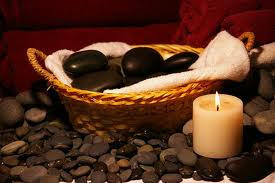
- Squirt a small amount of massage oil into your hand and rub the oil on their right leg. Hot stone therapy includes utilizing a stone as a massage tool.
- Rub a heated stone up and down their right leg.
- Switch the stones to their right leg, and use the same hot stone massage techniques on the left leg.
- Remove the sheet from their back and move the stones to their lower back. Cover their legs with the sheet to keep them warm.
- Use hot rocks to massage their buttocks.
- Place 1 stone on their neck and 1 stone on each shoulder. Move the rest of the stones to their spine.
- Add more massage oil as necessary. Use hot rocks to massage the upper back, neck and shoulder blades.
- Take the stones off, and have the person turn onto their back. Hot stone massage will work on both sides of the body. Cover their upper body with the sheet.
- Set 3 stones on each calf, and use hot rocks to massage along their arms and legs.

- Change the position of the sheet and stones. Move the stones off their calves and place 1 of them near the heart, 1 close to the sternum and 1 on the belly button. Use hot rocks on each shoulder, and cover their lower body with the sheet.
- Massage their chest, stomach and neck. When using hot stone therapy, rub with a circular motion around their stomach area.
- Add more oil to your palm, and massage their face and scalp with your fingers
- After you have completed their massage, you can now align each of the stones onto each of the chakras for alignment as described below, and then you can leave your client to relax and/or meditate for 10-15 minutes to some soft music.
Opening and Balancing the Chakras
The hot massage stones are unique, in that they can also be used to open and balance the 7 main etheric chakras of the human body.
Use the following picture as a guide on where to place the stones, with each of the specific chakra symbols matching the location on where they are placed.
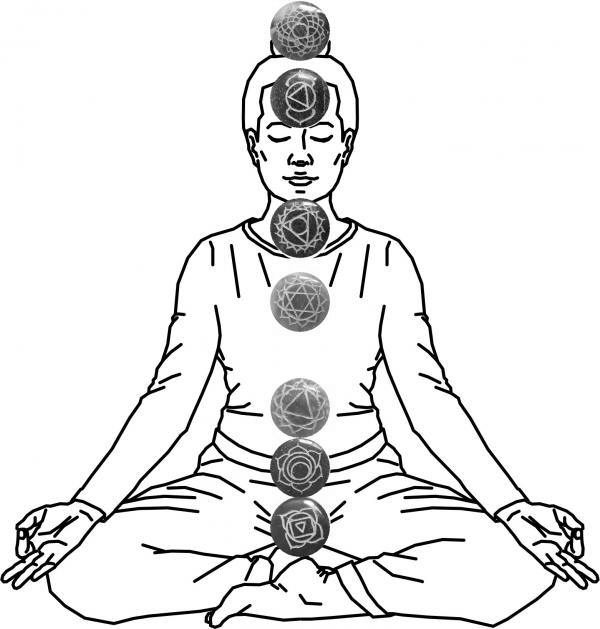
Each of the chakras and associated symbols are explained below;
Note that each of the stones is 3-4 cm in diameter and approx 8 mm thick.
Returns Policy
You may return most new, unopened items within 30 days of delivery for a full refund. We'll also pay the return shipping costs if the return is a result of our error (you received an incorrect or defective item, etc.).
You should expect to receive your refund within four weeks of giving your package to the return shipper, however, in many cases you will receive a refund more quickly. This time period includes the transit time for us to receive your return from the shipper (5 to 10 business days), the time it takes us to process your return once we receive it (3 to 5 business days), and the time it takes your bank to process our refund request (5 to 10 business days).
If you need to return an item, simply login to your account, view the order using the "Complete Orders" link under the My Account menu and click the Return Item(s) button. We'll notify you via e-mail of your refund once we've received and processed the returned item.
Shipping
We can ship to virtually any address in the world. Note that there are restrictions on some products, and some products cannot be shipped to international destinations.
When you place an order, we will estimate shipping and delivery dates for you based on the availability of your items and the shipping options you choose. Depending on the shipping provider you choose, shipping date estimates may appear on the shipping quotes page.
Please also note that the shipping rates for many items we sell are weight-based. The weight of any such item can be found on its detail page. To reflect the policies of the shipping companies we use, all weights will be rounded up to the next full pound.
Related Products
- Choosing a selection results in a full page refresh.




